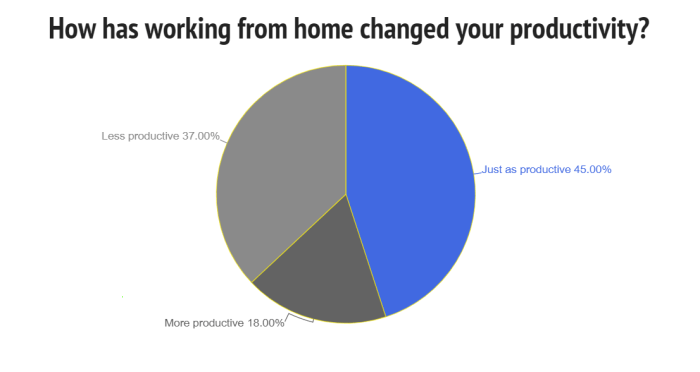Remote Work Productivity sets the stage for a seamless blend of work and lifestyle, diving into the benefits, challenges, and best practices of working remotely with a fresh perspective that resonates with the modern workforce.
As we delve deeper into the dynamics of remote work productivity, you’ll uncover a treasure trove of insights and strategies to elevate your efficiency and well-being in a digital workspace.
Benefits of Remote Work Productivity

Remote work offers numerous advantages that can significantly boost productivity in various ways. With the right tools and technologies, remote employees can achieve higher levels of efficiency and effectiveness compared to traditional office settings. One key factor contributing to this productivity is the flexibility in work hours that remote work provides, allowing individuals to work during their most productive times.
Increased Efficiency and Effectiveness
- Remote work eliminates commuting time, allowing employees to start work promptly and avoid distractions typically encountered in office environments.
- Virtual collaboration tools such as video conferencing and project management platforms facilitate seamless communication and task coordination among remote teams, enhancing overall productivity.
- Research has shown that remote workers tend to be more focused and engaged, leading to higher quality work output and faster task completion.
Flexible Work Hours
- Employees have the freedom to choose their work hours based on their peak productivity times, resulting in better performance and output.
- Flexible work schedules accommodate personal responsibilities, reducing stress and improving work-life balance, which in turn positively impacts productivity.
- Remote work allows individuals to work in environments where they feel most comfortable and inspired, leading to increased creativity and efficiency.
Tools and Technologies for Remote Work Productivity
- Project management software like Trello and Asana help remote teams stay organized and on track with their tasks and deadlines.
- Communication tools such as Slack and Microsoft Teams enable real-time collaboration and quick decision-making, improving overall team productivity.
- Time tracking apps like Toggl and RescueTime help remote workers manage their time effectively and identify areas for improvement in their workflow.
Challenges of Remote Work Productivity

Working remotely comes with its own set of challenges that can hinder productivity if not addressed effectively. Distractions, lack of boundaries between work and personal life, and maintaining motivation are some common obstacles faced by remote workers.
Overcoming Distractions
One of the biggest challenges of remote work is dealing with distractions that are not present in a traditional office setting. To overcome this, create a dedicated workspace free from distractions, establish a routine, and communicate boundaries with family members or housemates.
Setting Boundaries
It’s crucial to set boundaries between work and personal life when working remotely. Make sure to define specific work hours, take breaks, and avoid working in areas associated with leisure activities. This separation helps maintain focus and prevent burnout.
Staying Motivated
Staying motivated while working from home can be tough, especially without the presence of coworkers or a structured office environment. To stay motivated, set clear goals, create a daily schedule, and reward yourself for completing tasks. Regular exercise and social interactions can also help boost motivation.
Best Practices for Remote Work Productivity
In order to maximize productivity while working remotely, it is essential to implement certain best practices that can help you stay focused and efficient in your work.
Effective Time Management Techniques for Remote Workers, Remote Work Productivity
- Create a daily schedule with specific time blocks for different tasks to stay organized.
- Use time tracking tools to monitor how you spend your time and make adjustments accordingly.
- Avoid multitasking and focus on one task at a time to ensure quality work.
- Take regular breaks to prevent burnout and maintain productivity throughout the day.
Significance of Creating a Designated Workspace for Optimal Productivity
- Set up a dedicated workspace free from distractions to create a conducive environment for work.
- Ensure your workspace is comfortable, well-lit, and ergonomically designed to promote focus and productivity.
- Keep your workspace organized and clutter-free to minimize distractions and enhance efficiency.
- Personalize your workspace with inspiring decor or plants to boost creativity and motivation.
Communication Strategies for Collaboration and Teamwork in Remote Settings
- Utilize communication tools like video conferencing, chat platforms, and project management software to stay connected with team members.
- Establish regular check-in meetings with colleagues to discuss progress, address challenges, and foster collaboration.
- Create clear communication guidelines to ensure everyone is on the same page and promote effective teamwork.
- Encourage open and transparent communication to build trust and strengthen team dynamics in a remote work environment.
Tips for Maintaining Work-Life Balance While Working Remotely
- Set boundaries between work and personal life by establishing specific work hours and sticking to them.
- Create a routine that includes time for breaks, exercise, and relaxation to avoid burnout and maintain well-being.
- Engage in activities outside of work, such as hobbies or socializing, to recharge and prevent work from taking over your life.
- Prioritize self-care and mental health by practicing mindfulness, meditation, or other stress-relieving techniques.
Impact of Remote Work Productivity on Mental Health
Working remotely can have a significant impact on mental well-being and productivity. It is important to address the challenges that may arise to prevent burnout and maintain mental wellness while working from home. Implementing self-care routines and creating a supportive remote work environment are crucial for promoting mental health among remote workers.
Preventing Burnout
One way to prevent burnout when working remotely is to establish clear boundaries between work and personal life. Set specific work hours and stick to them, avoid working in bed or other leisure spaces, and take regular breaks to recharge.
Maintaining Mental Wellness
Engaging in regular physical activity, practicing mindfulness or meditation, and staying connected with colleagues through virtual meetings can help maintain mental wellness while working remotely. Prioritizing self-care activities such as getting enough sleep, eating well, and taking time for hobbies is also essential.
Importance of Self-Care
Self-care routines play a vital role in promoting mental health for remote workers. Taking breaks throughout the day, setting realistic goals, and seeking support from peers or mental health professionals when needed are important aspects of self-care. Remembering to prioritize mental health and well-being is key to long-term productivity and satisfaction.
Building a Supportive Remote Work Environment
Creating a supportive remote work environment involves fostering open communication, providing resources for mental health support, and promoting work-life balance. Encouraging team members to share their feelings and concerns, offering flexibility in work schedules, and organizing virtual team-building activities can help build a strong support system for mental health in a remote work setting.